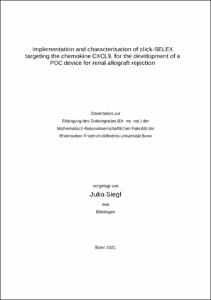Siegl, Julia: Implementation and characterisation of click-SELEX targeting the chemokine CXCL9, for the development of a POC device for renal allograft rejection. - Bonn, 2021. - Dissertation, Rheinische Friedrich-Wilhelms-Universität Bonn.
Online-Ausgabe in bonndoc: https://nbn-resolving.org/urn:nbn:de:hbz:5-64428
Online-Ausgabe in bonndoc: https://nbn-resolving.org/urn:nbn:de:hbz:5-64428
@phdthesis{handle:20.500.11811/9393,
urn: https://nbn-resolving.org/urn:nbn:de:hbz:5-64428,
author = {{Julia Siegl}},
title = {Implementation and characterisation of click-SELEX targeting the chemokine CXCL9, for the development of a POC device for renal allograft rejection},
school = {Rheinische Friedrich-Wilhelms-Universität Bonn},
year = 2021,
month = nov,
note = {Renal allograft rejection is a serious medicinal condition, as appr. 25 % of the allografts are rejected. This medical disorder will lead to death of the patient if not treated early. Currently the gold standard to diagnose renal allograft rejections is renal biopsy, which is however invasive and time consuming. Thus, an innovative diagnostic point of care (POC) test would make the diagnosis of renal rejection easier, faster and saver for the patients. CXCL9 can be found in urine of patients suffering from renal allograft rejection and is more sensitive than routinely used biomarkers. Thus, detection of CXCL9 by a POC test presents a valid approach for the diagnosis of this disease. Aptamers and chemically modified aptamers (clickmers) are short single stranded DNA molecules which are capable of binding their target with high affinity and specificity. Moreover, aptamers are thermostable at room temperature, have no batch-to-batch variations, and can be easily modified. Thus, they are a good molecular tool for the detection of biomarkers and the use in POC devices.
Selection of clickmers was already shown to be successful, but to date it is unclear if and how the number of modifications impacts the enzymatic amplification efficiency and consequential the click-SELEX success. In the present study, it was shown that the number of modifications within the DNA impacted PCR amplification as well as to some extent the selection success. While a low number of modifications seemed to be advantageous for enzymatic amplification, the click-SELEX, targeting the model protein C3-GFP, was faster enriched using a DNA library with a higher number of modifications.
After optimizing the library design the click-SELEX approach was followed to lay the foundation for the development of a POC device utilizing the detection of the biomarker CXCL9. Two clickmers were selected that bound with high affinity and specificity to CXCL9. Both sequences can detect CXCL9 under different buffer conditions as well as human urine. Lastly it was shown that both sequences interacted with endogenous CXCL9 at pathophysiological concentrations in a sandwich assay using a CXCL9 binding antibody.
Therefore, those novel sequences were revealed as powerful tool for the development of a sensitive POC device to diagnose renal allograft rejection, which will allow fast treatment of those patients in the future.},
url = {https://hdl.handle.net/20.500.11811/9393}
}
urn: https://nbn-resolving.org/urn:nbn:de:hbz:5-64428,
author = {{Julia Siegl}},
title = {Implementation and characterisation of click-SELEX targeting the chemokine CXCL9, for the development of a POC device for renal allograft rejection},
school = {Rheinische Friedrich-Wilhelms-Universität Bonn},
year = 2021,
month = nov,
note = {Renal allograft rejection is a serious medicinal condition, as appr. 25 % of the allografts are rejected. This medical disorder will lead to death of the patient if not treated early. Currently the gold standard to diagnose renal allograft rejections is renal biopsy, which is however invasive and time consuming. Thus, an innovative diagnostic point of care (POC) test would make the diagnosis of renal rejection easier, faster and saver for the patients. CXCL9 can be found in urine of patients suffering from renal allograft rejection and is more sensitive than routinely used biomarkers. Thus, detection of CXCL9 by a POC test presents a valid approach for the diagnosis of this disease. Aptamers and chemically modified aptamers (clickmers) are short single stranded DNA molecules which are capable of binding their target with high affinity and specificity. Moreover, aptamers are thermostable at room temperature, have no batch-to-batch variations, and can be easily modified. Thus, they are a good molecular tool for the detection of biomarkers and the use in POC devices.
Selection of clickmers was already shown to be successful, but to date it is unclear if and how the number of modifications impacts the enzymatic amplification efficiency and consequential the click-SELEX success. In the present study, it was shown that the number of modifications within the DNA impacted PCR amplification as well as to some extent the selection success. While a low number of modifications seemed to be advantageous for enzymatic amplification, the click-SELEX, targeting the model protein C3-GFP, was faster enriched using a DNA library with a higher number of modifications.
After optimizing the library design the click-SELEX approach was followed to lay the foundation for the development of a POC device utilizing the detection of the biomarker CXCL9. Two clickmers were selected that bound with high affinity and specificity to CXCL9. Both sequences can detect CXCL9 under different buffer conditions as well as human urine. Lastly it was shown that both sequences interacted with endogenous CXCL9 at pathophysiological concentrations in a sandwich assay using a CXCL9 binding antibody.
Therefore, those novel sequences were revealed as powerful tool for the development of a sensitive POC device to diagnose renal allograft rejection, which will allow fast treatment of those patients in the future.},
url = {https://hdl.handle.net/20.500.11811/9393}
}






